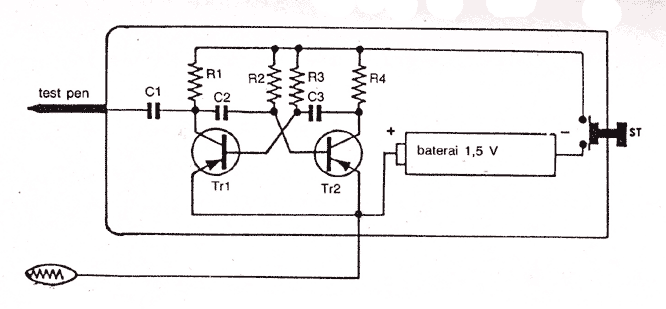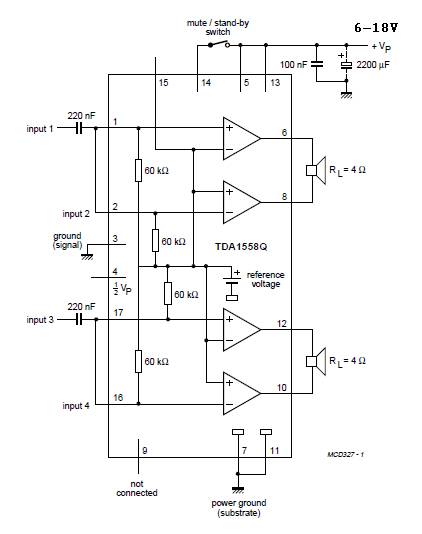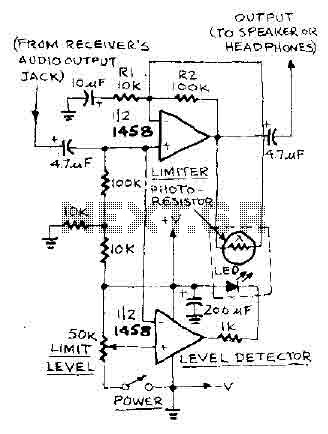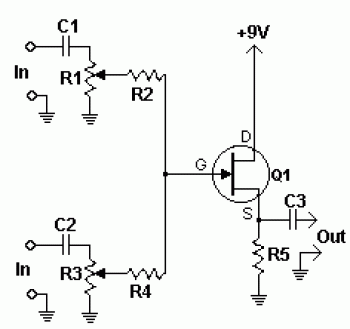
Audio Mixer based JFET 2N3819
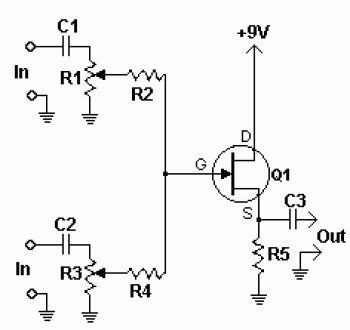
A mixer can have as many or as few channels as needed by duplicating the input sections shown in the schematic design. An audio amplifier is an electronic device that amplifies low-power audio signals, which primarily consist of frequencies ranging from 20 Hz to 20,000 Hz—the human hearing range—to a level suitable for driving loudspeakers. It serves as the final stage in a standard audio playback chain. The earlier stages in this chain typically include low-power audio amplifiers that perform functions such as pre-amplification, equalization, tone control, mixing/effects, or audio sources like record players, CD players, and cassette players. Most audio amplifiers require these low-level inputs to conform to line levels. While the input signal to an audio amplifier may only measure a few hundred microwatts, the output can reach tens, hundreds, or even thousands of watts. Additional information about power audio amplifiers can be found on Wikipedia. A video tutorial demonstrates how to build a very simple audio amplifier based on the LM386 amplifier chip, which can be constructed for less than $20 (or possibly under $8 in some regions) and is capable of amplifying any low-level audio signal, including those from a guitar, bass, or MP3 player.
An audio amplifier operates by increasing the amplitude of an audio signal, allowing it to drive loudspeakers effectively. The design typically includes several key components: input stages, gain stages, and output stages. The input stage often consists of a differential amplifier that processes the incoming audio signal, ensuring that it is free from noise and distortion. Following this, the gain stage uses transistors or operational amplifiers to increase the signal strength. The output stage is responsible for delivering the amplified signal to the loudspeakers.
In a practical application, the mixer may include multiple channels, each with its own input section, allowing for the integration of various audio sources. Each channel can be adjusted for volume and tone, enabling precise control over the final output mix. Additionally, the use of equalization and effects can enhance the audio quality, making the output more suitable for different listening environments or personal preferences.
The LM386 amplifier chip is a popular choice for simple audio amplification projects due to its low cost and ease of use. It features a built-in gain of 20, which can be increased by adding external resistors and capacitors. This chip is particularly suitable for battery-powered applications, as it operates at low voltage and draws minimal current. The circuit design for an LM386-based amplifier typically includes a power supply, input coupling capacitors, feedback resistors for gain adjustment, and output capacitors to block DC while passing the amplified audio signal to the speakers.
Overall, audio amplifiers and mixers play a crucial role in audio signal processing, ensuring that low-level signals are effectively amplified to drive loudspeakers and deliver high-quality sound for various applications.As numerous or as few channels as are needed may be added to the mixer. Do this by just duplicating the input "sections" that are shown on the schematic design. An audio amplifier is an electronic amplifier that amplifies low-power audio signals (signals composed primarily of frequencies between 20 - 20 000 Hz, the human range of hearing) to a lev el suitable for driving loudspeakers and is the final stage in a typical audio playback chain. The preceding stages in such a chain are low power audio amplifiers which perform tasks like pre-amplification, equalization, tone control, mixing/effects, or audio sources like record players, CD players, and cassette players. Most audio amplifiers require these low-level inputs to adhere to line levels. While the input signal to an audio amplifier may measure only a few hundred microwatts, its output may be tens, hundreds, or thousands of watts.
More explanation about power audio amplifier can be found at wikipedia. org This is a video tutorial about how to a very simple audio amplifier based on the LM386 amplifier chip. It can be built for less than $20 (or might be less than $8 in some countries) and used to amplify any low level audio signal including a guitar, bass or mp3 player.
🔗 External reference
An audio amplifier operates by increasing the amplitude of an audio signal, allowing it to drive loudspeakers effectively. The design typically includes several key components: input stages, gain stages, and output stages. The input stage often consists of a differential amplifier that processes the incoming audio signal, ensuring that it is free from noise and distortion. Following this, the gain stage uses transistors or operational amplifiers to increase the signal strength. The output stage is responsible for delivering the amplified signal to the loudspeakers.
In a practical application, the mixer may include multiple channels, each with its own input section, allowing for the integration of various audio sources. Each channel can be adjusted for volume and tone, enabling precise control over the final output mix. Additionally, the use of equalization and effects can enhance the audio quality, making the output more suitable for different listening environments or personal preferences.
The LM386 amplifier chip is a popular choice for simple audio amplification projects due to its low cost and ease of use. It features a built-in gain of 20, which can be increased by adding external resistors and capacitors. This chip is particularly suitable for battery-powered applications, as it operates at low voltage and draws minimal current. The circuit design for an LM386-based amplifier typically includes a power supply, input coupling capacitors, feedback resistors for gain adjustment, and output capacitors to block DC while passing the amplified audio signal to the speakers.
Overall, audio amplifiers and mixers play a crucial role in audio signal processing, ensuring that low-level signals are effectively amplified to drive loudspeakers and deliver high-quality sound for various applications.As numerous or as few channels as are needed may be added to the mixer. Do this by just duplicating the input "sections" that are shown on the schematic design. An audio amplifier is an electronic amplifier that amplifies low-power audio signals (signals composed primarily of frequencies between 20 - 20 000 Hz, the human range of hearing) to a lev el suitable for driving loudspeakers and is the final stage in a typical audio playback chain. The preceding stages in such a chain are low power audio amplifiers which perform tasks like pre-amplification, equalization, tone control, mixing/effects, or audio sources like record players, CD players, and cassette players. Most audio amplifiers require these low-level inputs to adhere to line levels. While the input signal to an audio amplifier may measure only a few hundred microwatts, its output may be tens, hundreds, or thousands of watts.
More explanation about power audio amplifier can be found at wikipedia. org This is a video tutorial about how to a very simple audio amplifier based on the LM386 amplifier chip. It can be built for less than $20 (or might be less than $8 in some countries) and used to amplify any low level audio signal including a guitar, bass or mp3 player.
🔗 External reference
